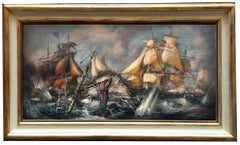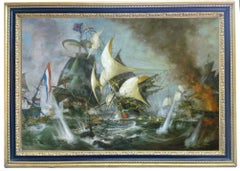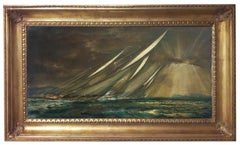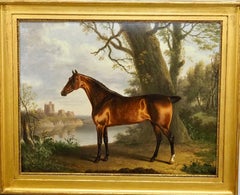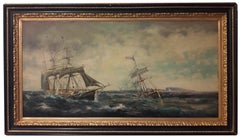John Stevens Art
to
6
6
6
6
3
3
Overall Height
to
Overall Width
to
1
4
2
2
1
6
6
6,952
3,302
2,514
1,213
6
6
6
6
Artist: John Stevens
SEA BATTLE - In the Manner of D.G.M. GaItalian- Sailing Boat Oil on Canvas Paint
By John Stevens
Located in Napoli, IT
Sea Battle - John Stevens Italia 2007 - Oil on canvas cm.50x130.
In this precious oil painting Stevens is inspired by the naval battles of the English painter Derek George Montague Gardner who, after a career as a civil engineer...
Category
Early 2000s English School John Stevens Art
Materials
Canvas, Oil
RACE IN THE GULF-English School - Italian Sealing boat Oil on Canvas Painting
By John Stevens
Located in Napoli, IT
Race in the gulf - John Stevens Italia 2007 - Oil on canvas cm.30x80.
John Stevens, using subtle washes of oil paint, slowly builds his highly detailed paintings of naval battle scen...
Category
Early 2000s English School John Stevens Art
Materials
Oil, Canvas
SEA BATTLE - English School - Italian Sealing Boat Oil on Canvas Painting
By John Stevens
Located in Napoli, IT
Battleship - John Stevens Italia 2007 - Oil on canvas cm.40x80.
In this precious oil painting Stevens is inspired by the naval battles of the English painter...
Category
Early 2000s English School John Stevens Art
Materials
Oil, Canvas
SAILING - English School -Italian Sailing Boat Oil on Canvas Painting
By John Stevens
Located in Napoli, IT
Sailing - John Stevens Italia 2006 - Oil on canvas cm. 60x120.
John Stevens, using subtle washes of oil paint, slowly builds his highly detailed paintings of sea battle scenes and ro...
Category
Early 2000s English School John Stevens Art
Materials
Canvas, Oil
SEA BATTLE - English School - Italian Sailing Boat Oil on Canvas Painting
By John Stevens
Located in Napoli, IT
Battleship - John Stevens Italia 2011 - Oil on canvas cm. 100x150
In this precious oil painting Stevens is inspired by the sea battles of the English paint...
Category
2010s English School John Stevens Art
Materials
Oil, Canvas
REGATTA IN THE GULF -English School Italian Sealing boat Oil on canvas Painting
By John Stevens
Located in Napoli, IT
Regatta in the gulf - John Stevens Italia 2006 - Oil on canvas cm.40x80.
Using thin washes of oil paint, John Stevens slowly builds up his highly detailed paintings of scenes of nava...
Category
Early 2000s Old Masters John Stevens Art
Materials
Oil, Canvas
Related Items
English late 19th century painting of a fox with a rabbit
By George William Horlor
Located in Bath, Somerset
A fox and a rabbit by a rabbit hole in woodland undergrowth, Circle of George William Horlor (1849-1895)
Oil on canvas in a giltwood frame.
Canvas size: 46 x 71cm
In frame: 59x 83cm
...
Category
Late 19th Century English School John Stevens Art
Materials
Canvas, Oil
A bay hunter in a landscape
By Charles Towne
Located in Stoke, Hampshire
Charles Towne (1763-1840)
A bay hunter in a landscape
signed and dated 'Charles Towne Pinxit 1816' lower left
Oil on canvas
Painting Size - 20 x 26
Framed Size - 25 x 31 in
Provena...
Category
Early 19th Century Old Masters John Stevens Art
Materials
Canvas, Oil
20th century View of Tower Bridge on the Thames in London, with boats, men
Located in Woodbury, CT
Interesting view of the Pool of London, an area known on the Thames near Tower Bridge where freight was loaded and unloaded from the earliest times of the City of London through the ...
Category
1930s English School John Stevens Art
Materials
Oil, Canvas
Free Shipping
H 30 in W 24 in
Shipping in Stormy Waters, Attributed to Italian Artist Francesco Guardi
By Francesco Guardi
Located in Stockholm, SE
The splendour of the tragic sea
Francesco Guardi and maritime painting in Venetian art
No Venetian painter was a stranger to the sea. After all, Venice was not only one of the most prominent ports of the Mediterranean, but indeed a city literally submerged in the ocean from time to time. Curiously however, the famous Venetian school of painting showed little interest in maritime motifs, favouring scenes from the iconic architecture of the city rather than seascapes. That is why this painting is a particularly interesting window into not only the painter Francesco Guardi himself – but to the significance of the element of water in art history, in absence as well as in the centre of attention.
Whether it be calm, sunny days with stunning views of the palaces alongside the canals of Venice or – more rarely – stormy shipwrecking tragedies at sea, water as a unifying element is integral to the works of painter Francesco Guardi (1712–1793). During his lifetime, Venetian art saw many of its greatest triumphs with names like Tiepolo or Canaletto gaining international recognition and firmly establishing Venice as one of the most vibrant artistic communities of Europe. While the city itself already in the 18th century was something of an early tourist spot where aristocrats and high society visited on their grand tour or travels, the artists too contributed to the fame and their work spread the image of Venice as the city of romance and leisure to an international audience, many of whom could never visit in person.
Still today, the iconic image of Venice with its whimsical array of palaces, churches and other historic buildings is much influenced by these artists, many of whom have stood the test of time like very well and remain some of the most beloved in all of art history. It was not primarily subtility, intellectual meanings or moral ideals that the Venetian art tried to capture; instead it was the sheer vibrancy of life and the fast-paced city with crumbling palaces and festive people that made this atmosphere so special. Of course, Venice could count painters in most genres among its residents, from portraiture to religious motifs, history painting and much else. Still, it is the Vedutas and views of the city that seems to have etched itself into our memory more than anything else, not least in the tradition of Canaletto who was perhaps the undisputed master of all Venetian painters.
Born into his profession, Francesco lived and breathed painting all his life. His father, the painter Domenico Guardi (1678–1716) died when Francesco was just a small child, yet both he and his brothers Niccolò and Gian Antonio continued in their fathers’ footsteps. The Guardi family belonged to the nobility and originated from the mountainous area of Trentino, not far from the Alps. The brothers worked together on more challenging commissions and supported each other in the manner typical of family workshops or networks of artists. Their sister Maria Cecilia married no other than the artist Giovanni Battista Tiepolo himself, linking the family to the most renowned Venetian name of the time. During almost a decade, Guardi worked in the studio of Michele Giovanni Marieschi, sometimes simply known as Michiel, a painted similar in both style and motif. Canaletto is, however, the artist Guardi is most often compared to since they shared a mutual fascination for depicting the architecture and cityscape of Venice.
During the course of his career, Guardi tried his hand in many different genres. He was as swift in painting landscapes, Vedutas of Venice, sacred motifs, interiors and architectural compositions as he was in a number of other motifs. His style is typical of the Venetian school but also distinct and personal once we look a little closer. There is an absolute certainty in the composition, the choice of which sometimes feels like that of a carefully calculated photograph – yet it is also very painterly, in the best sense of the word: fluid, bold, sensitive and full of character. The brushwork is rapid, intense, seemingly careless and extraordinarily minute at the same time; fresh and planned in a very enjoyable mixture. His interiors often capture the breath-taking spacious glamour of the palaces and all their exquisite decor. He usually constructed the motif through remarkably simple, almost spontaneous yet intuitively precise strokes and shapes. The result was a festive, high-spirited atmospheric quality, far away from the sterile and exact likeness that other painters fell victim to when trying to copy Canaletto.
The painting here has nothing of the city of Venice in it. On the contrary, we seem to be transported far away into the solitary ocean, with no architecture, nothing to hold on to – only the roaring sea and the dangerous cliffs upon which the ships are just moments away from being crushed upon. It is a maritime composition evoking both Flemish and Italian precursors, in the proud tradition of maritime painting that for centuries formed a crucial part of our visual culture.
This genre of painting is today curiously overlooked, compared to how esteemed and meaningful it was when our relationship to the sea was far more natural than it is today. When both people and goods travelled by water, and many nations and cities – Venice among them – depended entirely on sea fare, the existential connection to the ocean was much more natural and integrated into the imagination. The schools and traditions of maritime art are as manifold as there are countries connected to the sea, and all reflect the need to process the dangers and wonders of the ocean.
It could symbolize opportunity, the exciting prospects of a new countries and adventures, prospering trade, beautiful scenery as well as war and tragedy, loss of life, danger and doom. To say that water is ambivalent in nature is an understatement, and these many layers were something that artists explored in the most wondrous ways. Perhaps it takes a bit more time for the modern eye to identify the different nuances and qualities of historic maritime paintings, they may on first impression seem hard to differentiate from each other. But when allowing these motifs to unfold and tell stories of the sea in both fiction and reality – or somewhere in between – we are awarded with an understanding of how the oceans truly built our world.
In Guardi’s interpretation, we see an almost theatrically arranged shipwrecking scene. No less than five ships are depicted right in the moment of utter disaster. Caught in a violent storm, the waves have driven them to a shore of sharp cliffs and if not swallowed by the waves, crushing against the cliffs seems to be the only outcome. The large wooden ships are impressively decorated with elaborate sculpture, and in fact relics already during Guardi’s lifetime. They are in fact typical of Dutch and Flemish 17th century ships, giving us a clue to where he got the inspiration from. Guardi must have seen examples of Flemish maritime art, that made him curious about these particular motifs. One is reminded of Flemish painters like Willem van de Velde and Ludolf Backhuysen, and this very painting has indeed been mistakenly attributed to Matthieu van Plattenberg...
Category
18th Century Old Masters John Stevens Art
Materials
Canvas, Oil
Free Shipping
H 25.79 in W 29.14 in
Vedustist painter (Veneto school) - 19th century landscape painting - Padova
Located in Varmo, IT
Venetian painter (19th century) - Padua, Porta Liviana.
37.5 x 48.5 cm without frame, 50.5 x 60 cm with frame.
Oil on canvas, in a carved wooden frame.
Condition report: Good stat...
Category
Early 19th Century Old Masters John Stevens Art
Materials
Canvas, Oil
Free Shipping
H 19.89 in W 23.63 in
Shepherd with Sheep, Cows and a Goat in a Landscape by Jan Frans Soolmaker
Located in Stockholm, SE
Jan Frans Soolmaker (Flanders 1635‑1685)
Shepherd with Sheep, Cows and a Goat in a Landscape
oil on relined canvas
canvas size 56 x 53 cm
frame i...
Category
17th Century Old Masters John Stevens Art
Materials
Oil, Canvas
Free Shipping
H 22.05 in W 20.87 in
Late 18th century Antique English Moonlight over a lake and church landscape
By Henry Pether
Located in Woodbury, CT
Henry Pether, late 18th-century Moonlight lake Landscape.
Born into a family of artists, Henry was the son of Abraham Pether (1756-1812), a talented la...
Category
1790s Old Masters John Stevens Art
Materials
Canvas, Oil
Henry PetherLate 18th century Antique English Moonlight over a lake and church landscape, circa 1790
Free Shipping
H 28 in W 36 in
19th century English School, Bay Horse and a Terrier in a Landscape
Located in Bath, Somerset
A bay hunter and a black and white short haired dog (possibly a bull terrier) in an extensive English landscape. a rustic barn in the near distance. Indistinctly signed 'Br...' and d...
Category
Early 19th Century English School John Stevens Art
Materials
Canvas, Oil
19th Century English School Oil Painting - Hunting Scene Lady Side Saddle Horses
Located in Cirencester, Gloucestershire
Artist/ School: English School, 19th century
Title: English hunting scene, with a lady riding side-saddle.
Medium: oil painting on canvas, unframed
Size: painting: 10 x 12 inches...
Category
19th Century English School John Stevens Art
Materials
Canvas, Oil
John White, The Big One, Oil Painting
By John White
Located in Cheltenham, GB
This late 19th-century oil painting by Scottish artist John White (1851-1933) depicts a boy fishing in a stream with the sea beyond.
With his line taut, he leans back and looks opti...
Category
1880s English School John Stevens Art
Materials
Canvas, Oil
18th Century sporting horse portrait oil painting of a race horse and groom
By Francis Sartorius
Located in Nr Broadway, Worcestershire
Francis Sartorius
British, (1734-1804)
Bay Hunter & Groom
Oil on canvas, signed
Image size: 24.25 inches x 29.25 inches
Size including frame: 32 inches x 37 inches
A wonderful spor...
Category
18th Century Old Masters John Stevens Art
Materials
Oil, Canvas
A Sulky on the Road
Located in Hillsborough, NC
Horse and Sulky reminiscent of Currier and Ives by George Christopher Horner (1821-1881), British artist, imported by Saltire Gallerie. Signed and da...
Category
1840s English School John Stevens Art
Materials
Canvas, Oil
Previously Available Items
SAILING - English School - Italian Sailing Boat Oil on canvas Painting
By John Stevens
Located in Napoli, IT
Sailing - John Stevens Italia 2008 - Oil on canvas cm. 60x120.
Gold leaf gilded and ebony laquered wooden frame cm. 82 x 142
John Stevens, using subtle washes of oil paint, slowly bu...
Category
Early 2000s Old Masters John Stevens Art
Materials
Canvas, Oil
REGATTA IN THE GULF - John Stevens Italian sealing boat oil on canvas painting
By John Stevens
Located in Napoli, IT
Regatta in the gulf - John Stevens Italia 2006 - Oil on canvas cm.40x80.
Gold leaf gilded wooden frame cm.55x95.
Category
Early 2000s Old Masters John Stevens Art
Materials
Canvas, Oil
Sailers - John Stevens Italian Sailing Boat Oil on Canvas Painting
By John Stevens
Located in Napoli, IT
SAILERS - John Stevens Italia 2008 - Oil on canvas cm.80x100.
Gold gilded and mohogany laquered wooden frame.
Category
Early 2000s Old Masters John Stevens Art
Materials
Canvas, Oil
H 31.5 in W 39.38 in D 1.58 in
SEAPORT - Italian sailing boat oil on canvas painting by John Stevens
By John Stevens
Located in Napoli, IT
SEAPORT - John Stevens Italia 2008 - Oil on canvas cm.80x100.
Mohogany laquered wooden frame.
Category
Early 2000s Old Masters John Stevens Art
Materials
Canvas, Oil
RACE
By John Stevens
Located in Napoli, IT
Race - John Stevens Italia 2007 - Oil on canvas cm. 80x120
Category
Early 2000s Old Masters John Stevens Art
Materials
Canvas, Oil
SHIP IN THE GULF
By John Stevens
Located in Napoli, IT
Ship in the gulf - John Stevens Italia 2009 - Oil on canvas cm. 60x90
Category
Early 2000s Old Masters John Stevens Art
Materials
Canvas, Oil
John Stevens art for sale on 1stDibs.
Find a wide variety of authentic John Stevens art available for sale on 1stDibs. You can also browse by medium to find art by John Stevens in canvas, fabric, oil paint and more. Much of the original work by this artist or collective was created during the 21st century and contemporary and is mostly associated with the Old Masters style. Not every interior allows for large John Stevens art, so small editions measuring 32 inches across are available. Customers who are interested in this artist might also find the work of George Morland, John Horace Hooper, and Francis Plummer. John Stevens art prices can differ depending upon medium, time period and other attributes. On 1stDibs, the price for these items starts at $3,514 and tops out at $10,541, while the average work can sell for $5,177.


